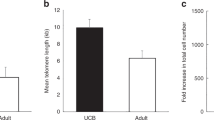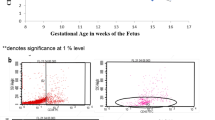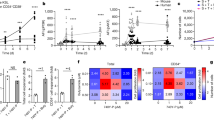Abstract
Assuming a threshold of 2 × 107 nucleated cells (NC)/kg body weight required for transplantation and 10 ± 5 × 108 NC per cord blood (CB) unit (n = 1828, July 1997), 100%, 65% and 25% of the CB units stored in the CB Bank Düsseldorf contain sufficient NC to engraft patients of 10 kg, 35 kg and 50–70 kg, respectively. Thus, there is a potential limitation for the use of CB in adults which, however, may be overcome by ex vivo expansion of cells important in the different phases of engraftment. Therefore, four combinations of SCF, Flt3-L, IL-3, erythropoietin and GM-CSF as well as three media were evaluated for their capacity to amplify hematopoietic progenitors. A prerequisite for expansion was the significantly higher recovery of CD34+ cells, colony-forming cells (CFC) and long-term culture-initiating cells (LTC-IC) by thawing cryopreserved CB units with an isotonic albumin/dextran solution. When CD34+ CB cells were cultured with the four cytokine combinations in H5100 medium, all combinations promoted an expansion of total cells (43 to 356-fold) and CFC (49 to 462-fold) within 7 days, however, early progenitors as defined by mixed-colony formation (CFU-GEMM) were substantially amplified only with SCF, Flt3-L plus IL-3 (94.3 ± 62.4-fold). H5100 medium or a serum-free medium supplemented with SCF, Flt3-L plus IL-3 were superior to 20% FCS/RPMI-1640 medium in the expansion of all progenitor cell types and were similarly effective in supporting the amplification of total cells, CFC, CFU-GM, BFU-E/CFU-E and LTC-IC (maximum at day 7: 6.7 ± 3.4-fold and 5.5 ± 0.5-fold, respectively). However, the serum-free medium promoted a significantly higher expansion of CFU-GEMM (176.9 ± 81.7-fold) than H5100 medium (83.5 ± 26.2-fold) at day 7 and only under serum-free conditions, CFU-GEMM were maintained over 14 days in tissue culture. These results demonstrate that committed progenitors as well as the more immature CFU-GEMM and LTC-IC can be substantially amplified at the same time without exhausting the proliferative potential.
This is a preview of subscription content, access via your institution
Access options
Subscribe to this journal
Receive 12 print issues and online access
$259.00 per year
only $21.58 per issue
Buy this article
- Purchase on Springer Link
- Instant access to full article PDF
Prices may be subject to local taxes which are calculated during checkout
Similar content being viewed by others
Author information
Authors and Affiliations
Rights and permissions
About this article
Cite this article
Kögler, G., Callejas, J., Sorg, R. et al. The effect of different thawing methods, growth factor combinations and media on the ex vivo expansion of umbilical cord blood primitive and committed progenitors. Bone Marrow Transplant 21, 233–241 (1998). https://doi.org/10.1038/sj.bmt.1701088
Received:
Accepted:
Published:
Issue Date:
DOI: https://doi.org/10.1038/sj.bmt.1701088
Keywords
This article is cited by
-
Ex Vivo Expansion of Human Umbilical Cord Blood CD34+ Cells in a Collagen Bead—Containing 3-Dimensional Culture System
International Journal of Hematology (2003)
-
Evaluation of the effect of cryopreservation on ex vivo expansion of hematopoietic progenitors from cord blood
Bone Marrow Transplantation (2001)
-
Successful treatment of relapsed CML after cord blood transplantation with donor leukocyte infusion IL-2 and IFNα
Bone Marrow Transplantation (2000)



